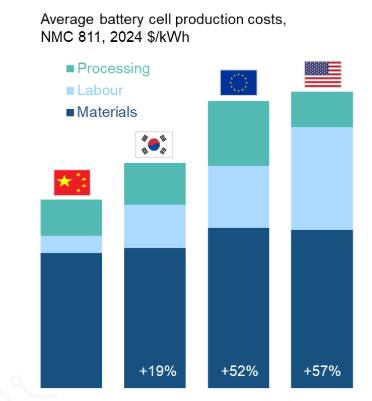Reading list 02/22/25
Waymo’s factory, a map of US land values, ships in the Arctic Circle, battery industry trends, and more.

Welcome to the reading list, a weekly roundup of news and links related to buildings, infrastructure, and industrial technology. This week we look at Waymo’s factory, a map of US land values, ships in the Arctic Circle, battery industry trends, and more. Roughly 2/3rds of reading list content is paywalled, so for full access become a paid subscriber.
No essay this week, but I’m working on a longer piece about jet engines that should be out next week.
Waymo’s factory
An enterprising Youtuber recorded some footage of Waymo's factory in Arizona, which is accumulating thousands of Waymo cars (presumably ahead of some larger roll-out). Apparently dozens of Jaguar i-paces are arriving at the factory each day. Via Autonomy Central:
Around 2,000 cars can be seen if you pause the footage to count each one. There may be more inside the adjacent buildings that are in the process of being built out. Our source tells us that this facility has been taking deliveries over the course of the last few months, with trucks being spotted here and there.
2000 cars is substantially more than the estimated 700 cars Waymo was operating as of August of last year, which to me suggests its plan to roll out service in more cities will ramp up quickly.
Korea’s 3 gigawatt datacenter
We’ve previously talked about the ever-increasing size of AI data centers, with OpenAI announcing its 5 gigawatt Stargate project and a 3 gigawatt data center being planned in India. Now South Korea is joining the fray with its own proposed 3 gigawatt data center. From the Wall Street Journal:
An investor group is planning one of the world’s largest data centers for artificial intelligence in South Korea, a sign of red-hot AI demand across the globe despite concern about the AI boom’s staying power.
If completed as envisioned by its backers, the data center will cost as much as $35 billion and pack up to 3 gigawatts of power…
Globally, it is rare for a single site’s available power—which determines how many number-crunching AI chips can be installed—to exceed 1 gigawatt. Power availability has become a constraint as AI models have become more complex and require more chips that gobble up more electricity. According to the research group Epoch AI, developing the largest AI models will likely require more than 5 gigawatts of electricity by 2030.
This suggests that the potential for AI models that are much cheaper to train, like (allegedly) China’s DeepSeek, aren’t yet dulling enthusiasm for AI infrastructure investments.
On the other hand, we’re now seeing rumors that Microsoft is backing off some its data center investments. Via Shanu Matthew:
Power outage maps
Poweroutage.us is a cool service that tracks power outages across the US on a county-by-county and utility-by-utility level. Below is a map of the power outages in Georgia at the time of this writing:
I’m currently working to get access to this historical data to do an analysis of it, so hopefully I’ll be able to write an essay about it in the coming weeks.
US land values
In other “cool map news”, PlacesLab, a research group at Boston University that studies “the effects and costs of environmental policies”, released this very cool map showing land values across the US.
This is, of course, another map that’s also a population map, but it’s nevertheless interesting.
This map was produced as part of research investigating the costs of conservation and protecting endangered species. The more valuable the land, the greater the cost of conservation efforts that prevent it from being built on, and this research suggests that the costs of conservation have been greatly underestimated. From the abstract:
The justification and targeting of conservation policy rests on reliable measures of public and private benefits from competing land uses. Advances in Earth system observation and modeling permit the mapping of public ecosystem services at unprecedented scales and resolutions, prompting new proposals for land protection policies and priorities. Data on private benefits from land use are not available at similar scales and resolutions, resulting in a data mismatch with unknown consequences. Here I show that private benefits from land can be quantified at large scales and high resolutions, and that doing so can have important implications for conservation policy models. I developed high-resolution estimates of fair market value of private lands in the contiguous United States by training tree-based ensemble models on 6 million land sales. The resulting estimates predict conservation cost with up to 8.5 times greater accuracy than earlier proxies. Studies using coarser cost proxies underestimate conservation costs, especially at the expensive tail of the distribution. This has led to underestimations of policy budgets by factors of up to 37.5 in recent work. More accurate cost accounting will help policy makers acknowledge the full magnitude of contemporary conservation challenges and can help improve the targeting of public ecosystem service investments.
Volta battery report
The Volta Foundation has released a very long (500+ slides) presentation on the state of the battery industry in 2024. A few notable highlights:
VC funding for battery startups is way down from its peak (though so is VC everywhere):
Battery manufacturing costs are, unsurprisingly, much lower in China:
But most of China’s batteries are used within China:
Different parts of the manufacturing have different risks of defects:
I haven’t had time to go through this whole presentation — this is just from the first 100 pages — but this is going to be my first stop whenever I need to better understand the battery manufacturing ecosystem.
Related, BYD is apparently building a very large battery installation for Saudi Arabia:
EV and BESS firm BYD has agreed a major order from the Saudi Electricity Company, the state utility and transmission & distribution (T&D) system operator of Saudi Arabia.
BYD has signed contracts with Saudi Electric Company totalling 12.5GWh which, combined with a previously delivered 2.6GWh project, bring its total co-operation with the company to 15.1GWh of battery energy storage systems (BESS).









